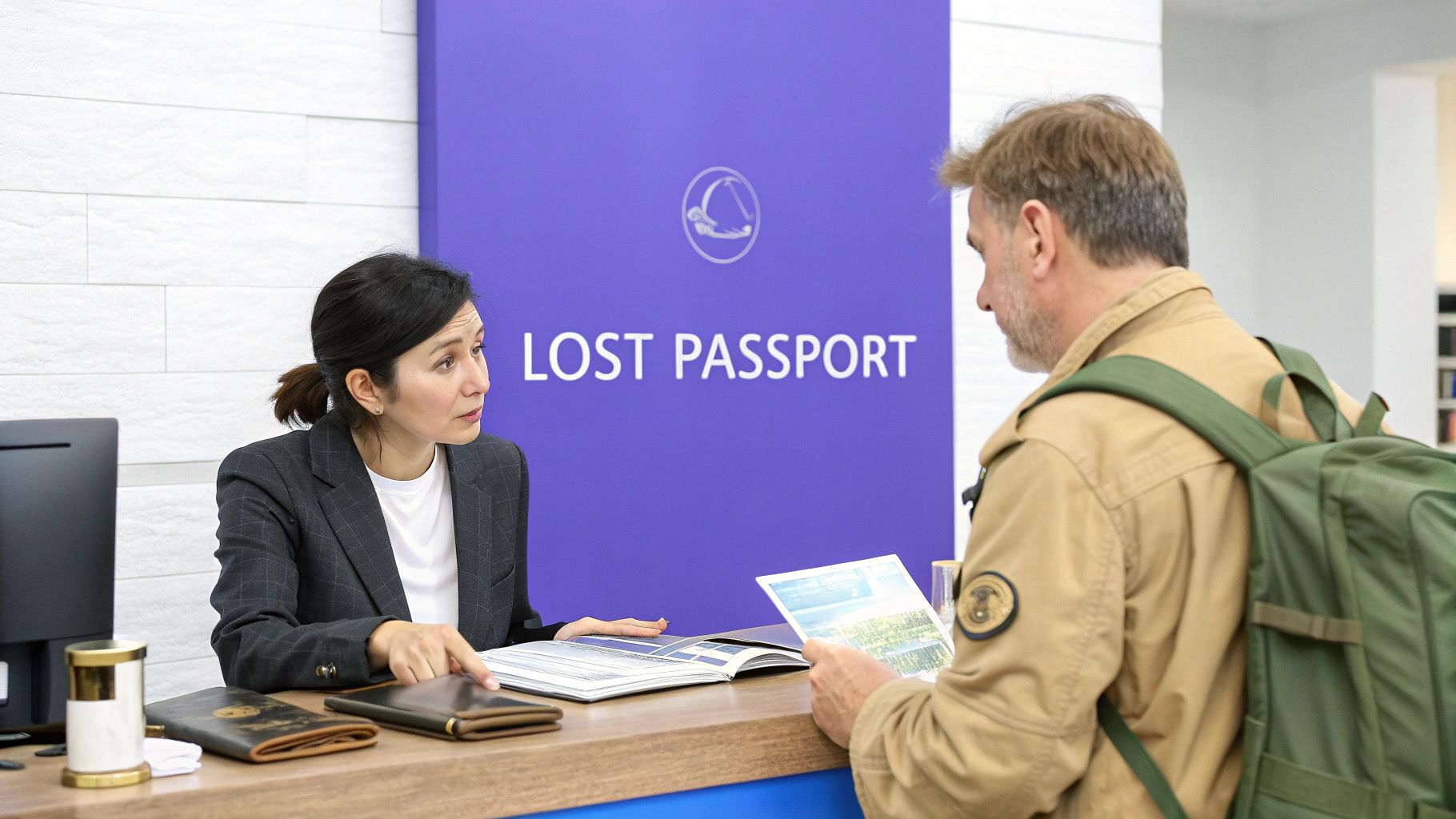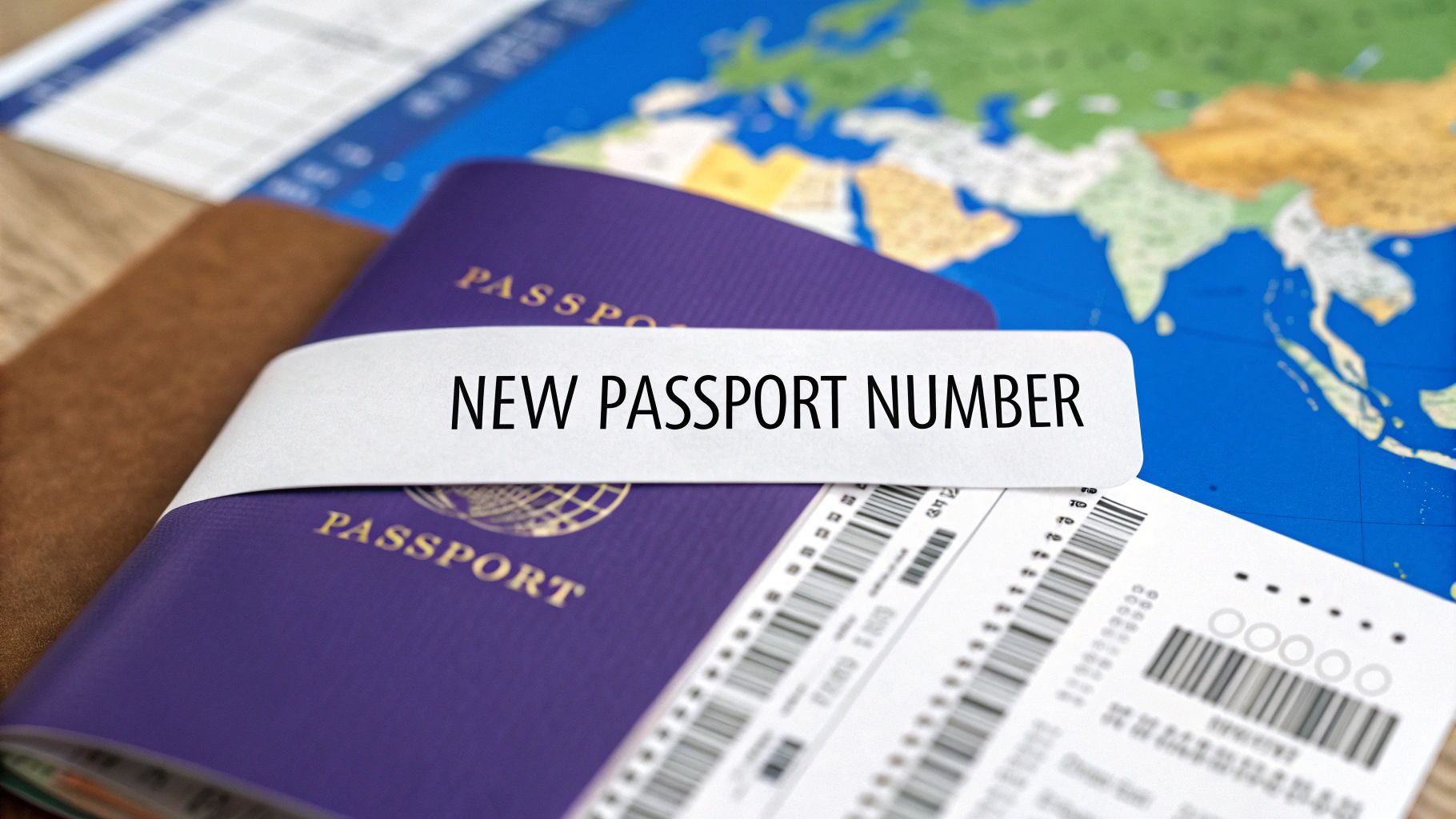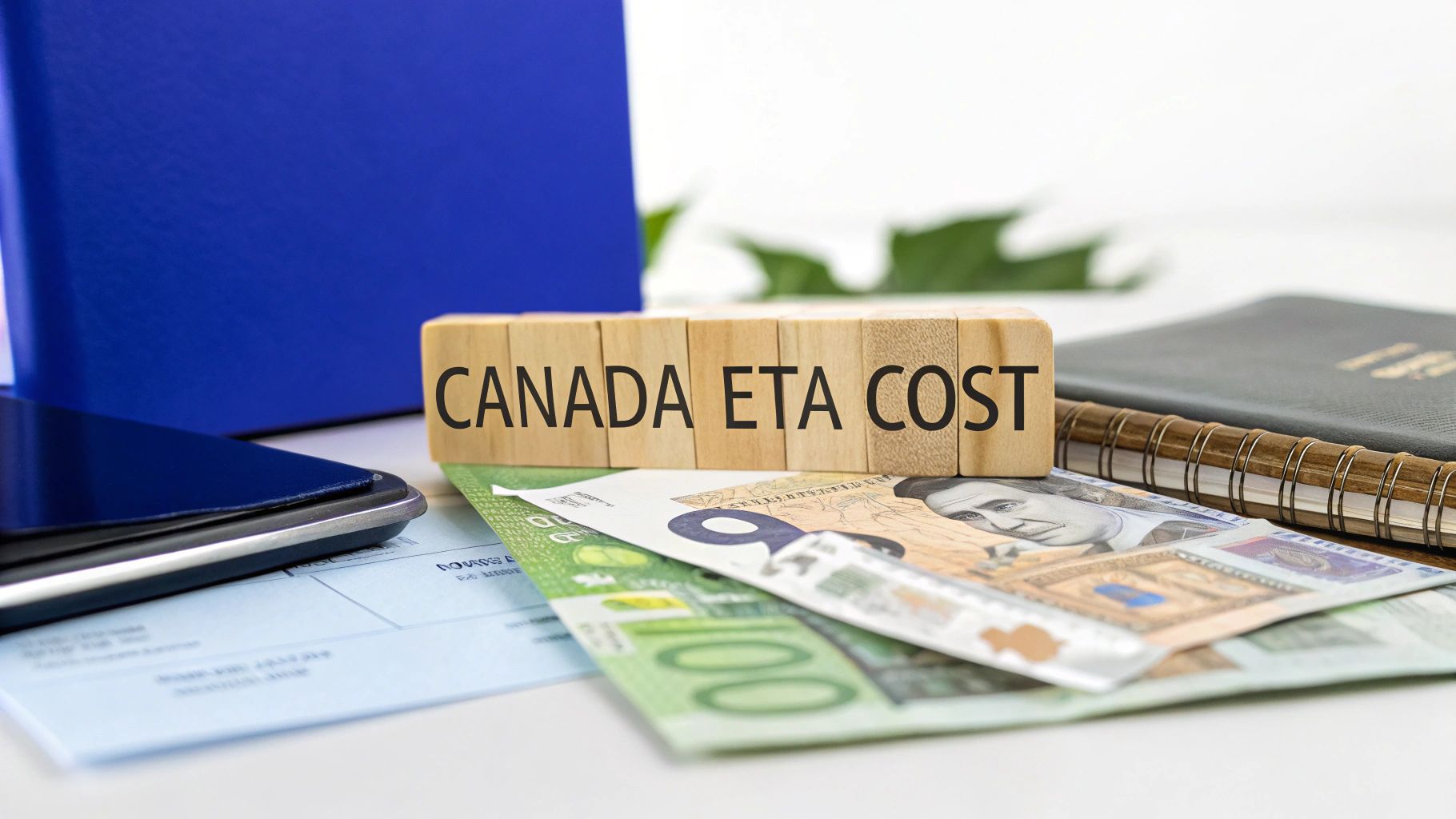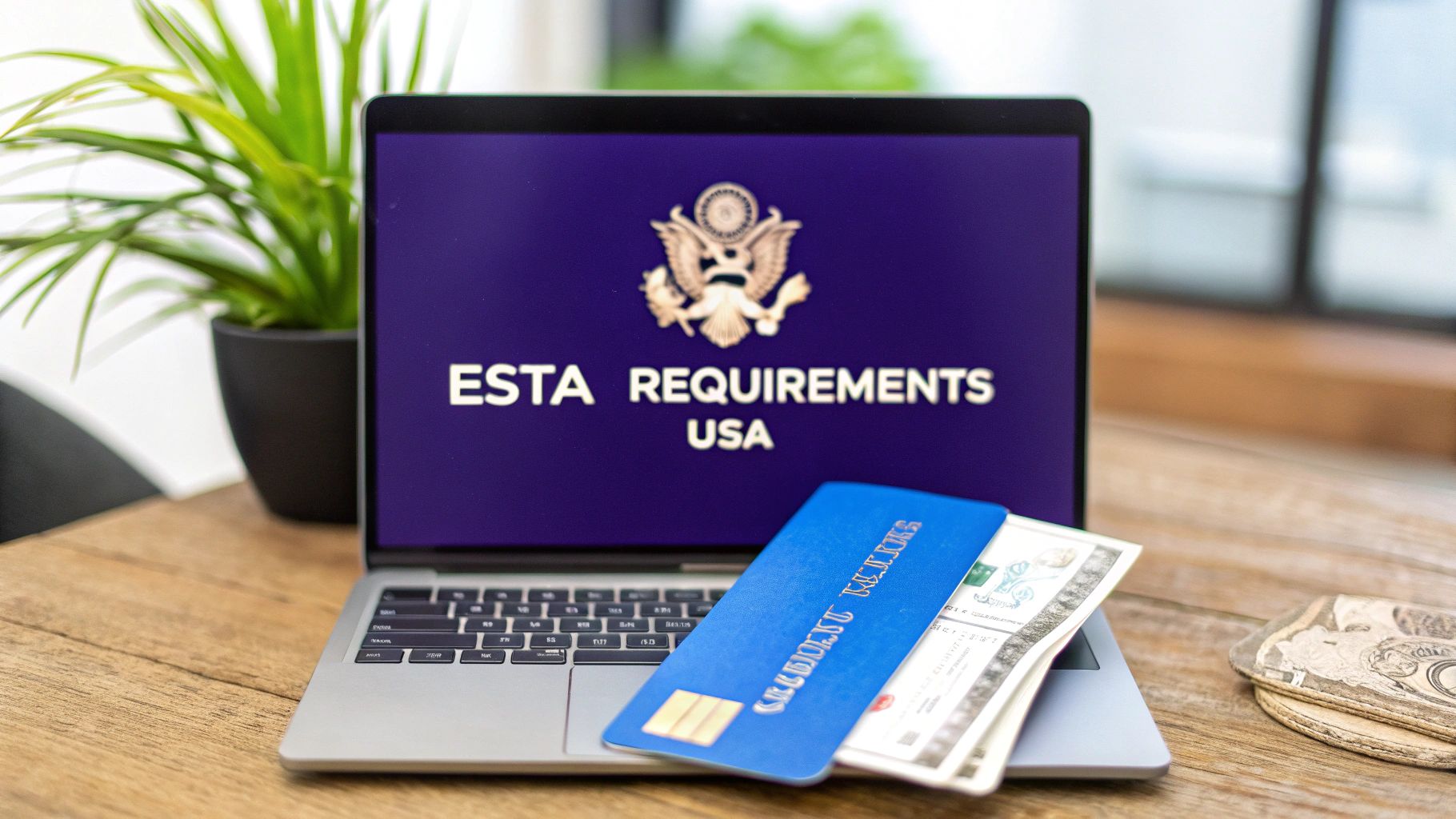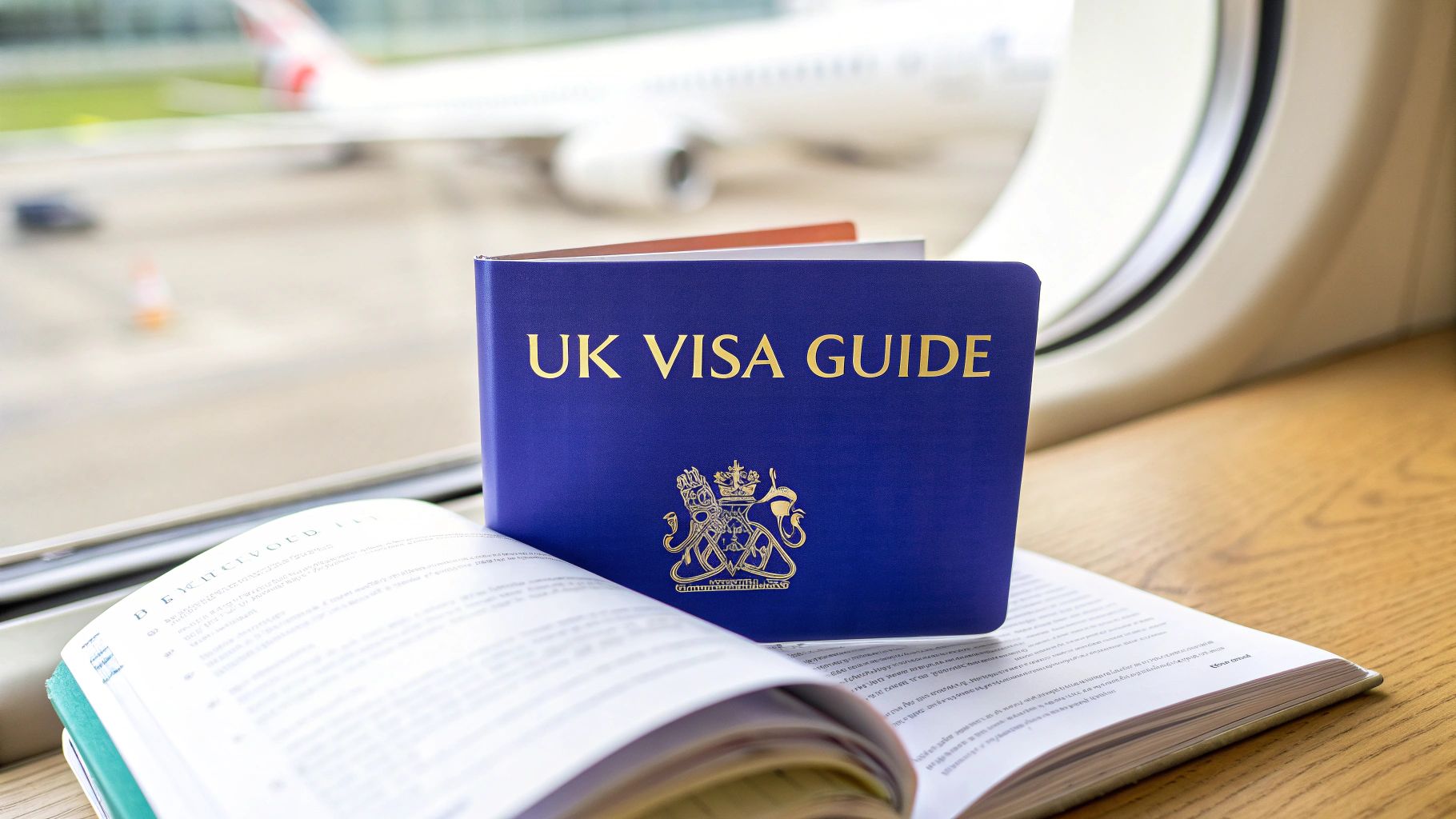
Your Essential Guide to a Travel Visa for UK
So, you're planning a trip to the UK. The first hurdle is figuring out exactly what kind of permission you need to enter the country. It often boils down to one simple question: do I need a full-blown travel visa, or is there an easier way?
For a growing number of visitors, the answer is the new Electronic Travel Authorization (ETA). It’s a modern, digital green light for entry. For others, the more traditional Standard Visitor Visa is the required path.
Let's break down how to choose the right one for your trip.
Choosing The Right UK Entry Permit
Figuring out UK entry rules can feel a bit like trying to solve a puzzle. This is your guide to finding the right pieces, starting with the key difference between the new ETA and the classic Standard Visitor Visa. Getting this right from the very beginning is the most important step you'll take.
Think of the ETA as a quick, digital pre-check for travelers from countries that don't need a visa for short visits. The Standard Visitor Visa, on the other hand, is a more formal application that requires more paperwork and a longer wait time.
ETA or Visa: Which One Is For You?
The decision really comes down to three things: your nationality, why you're visiting, and how long you plan to stay. Nail this from the start, and you'll avoid headaches, delays, or even a rejected application.
If you want to dive deeper into the different visa types, our detailed guide on UK visas and their requirements has you covered.
This image gives a great at-a-glance look at which path most travelers will take.
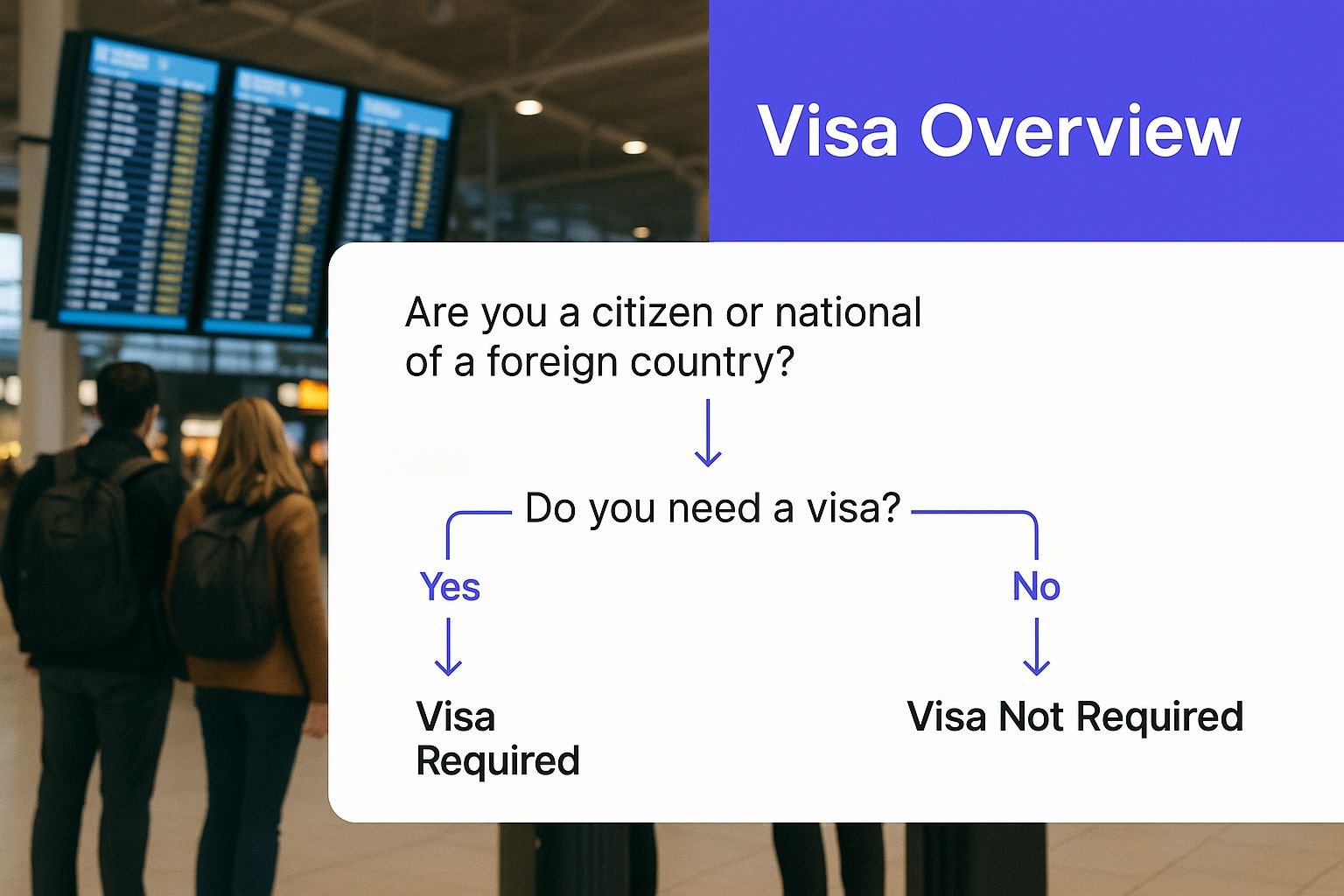
As you can see, it all hinges on whether your home country is on the UK's visa-exempt list. If it is, and you're just coming for a short trip, the ETA is almost certainly your route.
The whole point of the Electronic Travel Authorization for UK is to beef up border security while making travel smoother for millions of legitimate visitors. It lets the UK government pre-screen travelers before they even get on the plane, which cuts down on lines and uncertainty at the border.
Why The Right Choice Matters
Picking the wrong entry permit isn't a small mistake. It can cause serious problems, from being stopped at the check-in desk to being turned away by a border agent when you land in the UK.
Applying for the correct travel permission is not just a formality—it is a fundamental requirement for a successful and stress-free journey. An incorrect application can cost you both time and money, potentially jeopardizing your entire trip.
We'll help you figure out which option fits your plans, so you can start the right application with confidence and sidestep those common pitfalls right from the get-go.
UK ETA vs Standard Visitor Visa At a Glance
To make it even clearer, here's a quick comparison to help you see which UK entry permit you likely need.
| Feature | UK ETA (Electronic Travel Authorization) | Standard Visitor Visa |
|---|---|---|
| Who Needs It? | Nationals from visa-exempt countries (like the US, Canada, Australia, and EU nations). | Nationals from countries that are not on the visa-exempt list. |
| Purpose of Visit | Tourism, short business trips, visiting family, or transiting through the UK. | Similar purposes, but also covers longer stays or specific activities not permitted under ETA. |
| How Long Can You Stay? | Up to 6 months per visit. | Typically up to 6 months, but longer-term visas (2, 5, or 10 years) are available for frequent visitors. |
| Application Process | Fully online, simple form. Usually takes about 10-15 minutes. | More detailed online application, often requiring an in-person appointment at a visa centre for biometrics (fingerprints and photo). |
| Processing Time | Fast. Most are approved within 3 business days. | Slower. Can take anywhere from 3 weeks to several months, depending on the country and circumstances. |
| Cost | Low-cost. The UK government fee is £10. | More expensive. The standard fee starts at £115 for a 6-month visa and increases for longer-term options. |
| Validity | Valid for 2 years or until your passport expires, whichever comes first. Allows multiple entries. | Varies by visa type. A standard visa is for a single period, while long-term visas allow multiple entries over their duration. |
| What You Get | A digital authorization linked to your passport. No sticker or stamp. | A visa sticker (vignette) placed inside your passport. |
Hopefully, that table clears things up. The ETA is the fast, simple, and cheap option for eligible travelers, while the Visitor Visa is the more traditional—and involved—process for everyone else.
What Is the UK Electronic Travel Authorization?
The UK is overhauling its border system, and the new Electronic Travel Authorization (ETA) is at the center of it all. If you've ever gone through the process for a US ESTA or a Canadian eTA, you'll find the concept pretty familiar. Think of it as a digital permission slip that confirms you're cleared for travel to the UK.
But let's be clear: an ETA is not a visa. It's a much lighter, faster pre-screening process for people from countries who don't need a visa for short visits. This system lets UK authorities check a visitor's details before they even get on the plane, making things more secure for the UK and a lot smoother for you when you land.
Who Needs a UK ETA?
Whether or not you need an ETA comes down to your nationality. The system is being rolled out in stages, but the plan is for it to cover all visitors who can enter the UK without a visa for short trips.
This includes travelers from places like:
- The United States
- Canada
- Australia
- New Zealand
- All European Union countries
So, if you hold a passport from one of these countries and are planning a holiday, a quick business trip, or a family visit, getting a UK ETA application approved is a must before you go. The only exceptions are British and Irish citizens, who don't need one.
Think of the ETA as the digital key that lets you board your flight to the UK. Without that approval electronically tied to your passport, airlines simply won't let you travel, even if you're from a visa-free country.
What You Can Do With an ETA
An approved Electronic Travel Authorization opens the door for most common travel plans. It's built specifically for short-term stays, which covers what the vast majority of visitors need.
Here’s what you can do:
- Tourism and Leisure: Hit the big cities, explore the countryside, and enjoy a well-deserved holiday.
- Visiting Friends or Family: Catch up with your loved ones living in the UK.
- Short-Term Business: Pop over for meetings, conferences, or contract negotiations (but not to work).
- Short-Term Study: Take a course that lasts less than six months.
- Transit: Pass through a UK airport on your way to another country.
A single ETA is usually valid for a full two years, allowing you to make multiple trips to the UK. Each stay, however, is generally capped at six months. It’s perfect for people who visit often. For a deeper dive into how this differs from a formal visa, check out our complete comparison of the UK ETA and traditional visas.
Applying online is designed to be simple, but it’s surprisingly easy to mess up. A small typo in your passport number or getting your date of birth wrong can cause delays or even an outright rejection. If your ETA is refused, your only option is to apply for a Standard Visitor Visa—a much more complicated, expensive, and time-consuming headache.
To simplify your ETA application and increase your chances of approval, consider using AssistEntry — their experts guide you through the entire process, starting from just $79. As a trusted third-party application assistance provider, their service includes full verification and error-checking, giving you peace of mind.
How to Navigate the UK ETA Application
Applying for a UK Electronic Travel Authorisation (ETA) is meant to be a simple, all-digital process. But don't let the simplicity fool you. Like any official travel document, the details are everything. A tiny mistake can snowball into a frustrating delay or even a rejection, turning a quick task into a major headache.
This guide will walk you through the application from start to finish, pointing out the common traps so you can get it right the first time.
The whole thing happens online, and it can feel surprisingly quick. You'll enter personal info, your passport details, and answer a few standard security questions. While you can get it done in minutes, accuracy is way more important than speed.
Gathering Your Required Information
Before you even start the UK ETA application, do yourself a favor and get all your information together. Prepping everything beforehand is the best way to avoid rushing and making silly mistakes.
Here’s a quick checklist of what you'll need:
- A valid biometric passport: Make sure it’s from a country that's part of the UK ETA program.
- A recent digital photograph: You'll have to upload a clear photo that meets the specific digital photo rules set by the UK government.
- A valid email address: This one's critical. All communication, including your approved ETA, will be sent here.
- A credit or debit card: You'll need this to pay the application fee.
- Your travel details: While it’s not always a mandatory field, it’s a good idea to have your travel dates and UK address handy.
Got everything? Great. Now you’re ready to tackle the online form.
Avoiding Common Application Mistakes
The biggest hurdle with the ETA isn't that it's complicated—it's that small, avoidable errors can derail the whole thing. A single typo can flag your application for a manual review or, worse, get it flat-out denied. This is where most travellers get stuck.
Here are the most common mistakes we see:
- Passport Number Typos: Swapping a number or letter is incredibly easy to do but causes big problems. Your ETA is digitally tied to your passport, so it has to be a perfect match.
- Incorrect Dates: Mixing up your date of birth or your passport's expiration date is an instant rejection.
- Name Discrepancies: Your name must be entered exactly as it appears on the machine-readable part of your passport.
A rejected ETA doesn’t just mean you have to start over. It often forces you down the path of applying for a Standard Visitor Visa—a much more complex, expensive, and time-consuming process. Getting it right the first time is key.
This is exactly what a clear, easy-to-use application platform looks like. It guides you step-by-step through each section.
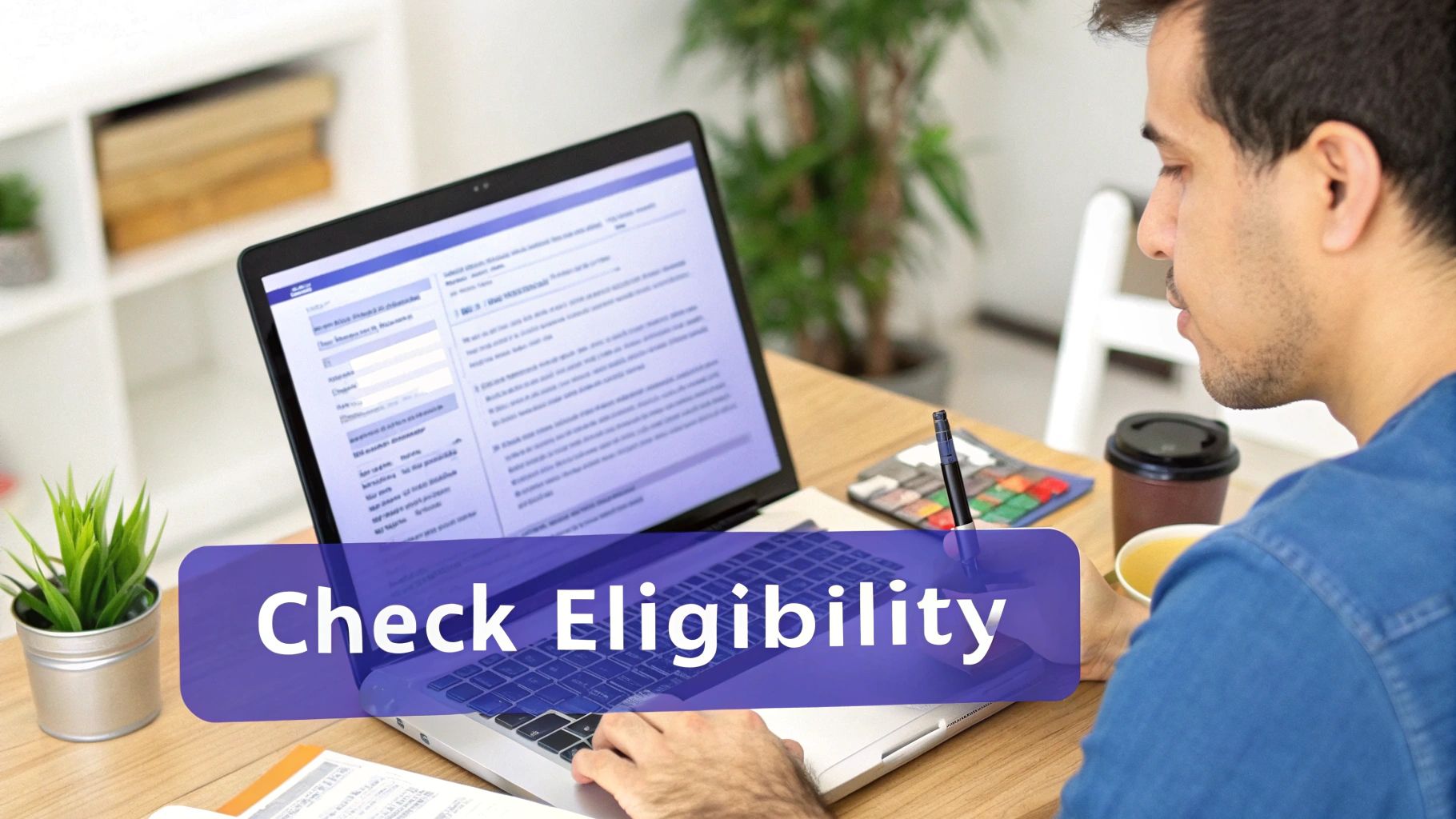
The organized layout breaks the form into manageable parts, making it much harder to miss a field or enter the wrong information.
The Value of an Expert Review
This is where a service like AssistEntry really proves its worth. Instead of just sending your application into the void and hoping for the best, our experts act as your final check. We review your entire application for errors, typos, and inconsistencies before it ever gets to the UK authorities. For a closer look at each step, check out our guide on how to apply for the UK ETA.
With our service starting at just $79 (which includes all government fees), you’re buying peace of mind. It’s a small price to pay to avoid the stress of a rejection and the potential disruption to your travel plans.
Let us handle the details. We’ll make sure the little mistakes don't cause big problems, so your journey to the UK can start off smoothly.
When You’ll Need a Standard Visitor Visa
While the new UK ETA system makes travel much simpler for millions, it's not a universal pass. For plenty of travelers, the classic Standard Visitor Visa is still the required document for getting into the country.
Knowing which one you need is the first and most important step. Guessing wrong can lead to a costly and stressful application mistake, so let's break down when a full visa is non-negotiable.
The biggest factor is your nationality. If you hold a passport from a country that isn't on the UK's visa-waiver or ETA-eligible list, you’ll have to apply for a Standard Visitor Visa, no matter how short your trip. This process is much more detailed than the quick ETA application and needs a lot more preparation.
Who Needs to Apply for a Visitor Visa?
You’ll definitely find yourself in the visa application lane if your travel plans fit any of these common scenarios. It's a good idea to check these well in advance, because visa processing takes a lot longer than an ETA.
You will need a Standard Visitor Visa if:
- Your Nationality Requires It: This is the most common reason. You’re a citizen of a country that isn't part of the UK's visa waiver program.
- You're Staying Longer Than Six Months: An ETA is strictly for short trips. If you want to stay in the UK for more than six months to visit family or for an extended holiday, a visa is mandatory.
- Your Reason for Visiting Isn't Covered by ETA Rules: The ETA is for tourism, short business meetings, and transit. If you're coming for private medical treatment, to get married, or for more involved business activities, you'll need a visa.
- You've Been Denied UK Entry Before: If you have a history of being refused entry into the UK or have been deported in the past, a standard visa application is almost always required so your case can be properly reviewed.
This tougher application process is a direct reflection of the UK's focus on managing its borders. Recent policy changes highlight this—net migration to the UK began to level off in 2024 and 2025 after hitting historic highs. For instance, the Labour government's announcement in May 2025 to close the care worker visa route and tighten other skilled worker rules is expected to cut visa approvals by around 98,000 each year. This shows the government is carefully balancing economic needs with immigration control.
Stricter Requirements and More Paperwork
Forget the simple ETA application. A Standard Visitor Visa application is a deep dive into your personal and financial situation. The responsibility is on you to prove you’re a genuine visitor who has every intention of leaving the UK when your trip is over.
You’ll need to prepare to meet several key requirements:
- Proof of Sufficient Funds: You must show you can pay for your entire trip without working or needing public funds. This usually means providing bank statements and other financial documents.
- Strong Ties to Your Home Country: This is often the most critical part of the application. You have to convince the Home Office you have a good reason to go back home, like a steady job, property you own, or close family commitments.
- A Biometric Appointment: Most applicants have to visit a visa application center in person to give their fingerprints and have a digital photograph taken.
At its heart, the Standard Visitor Visa application is about building trust with the UK Home Office. Every document you submit should help paint a clear, honest picture of a traveler with a solid plan and a compelling reason to return home.
Getting all of this right can feel overwhelming. For a more detailed walkthrough, check out our complete guide to the UK visitor visa application. It breaks down each step to help you put together a strong and successful case.
How Application Assistance Simplifies Your Journey
Let's be honest—navigating the rules for a travel visa for UK entry, whether it's an ETA or a full visa, can be a genuinely stressful part of planning your trip. The forms might look simple enough at first glance, but a tiny, honest mistake can easily lead to frustrating delays or even an outright rejection.
This is exactly where a third-party application assistance provider comes in. They can turn what feels like a high-stakes test into a smooth, straightforward process.
Think of a service like AssistEntry.com not as a government body, but as your dedicated travel partner. Their entire focus is to make sure your application is accurate, complete, and has the absolute best chance of getting approved quickly. They act as a critical safety net, catching common errors before they become big problems.
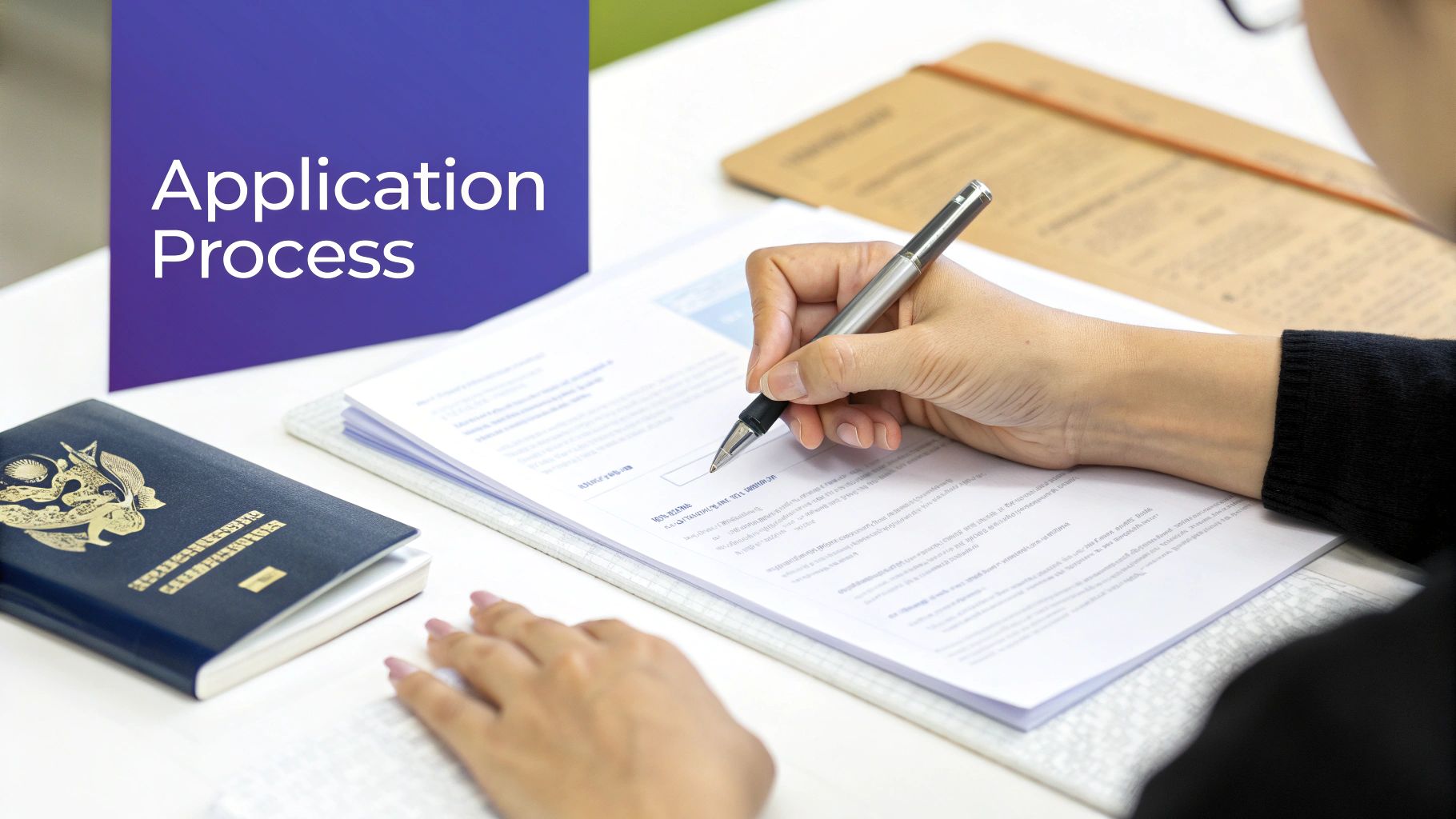
The Power of Expert Verification
The single biggest risk in any UK ETA application is simple human error. A mistyped passport number, an incorrect date of birth, or a name that doesn't perfectly match your travel document can all trigger an automatic denial. Once an ETA is denied, your only path forward is the much longer and more expensive process of applying for a Standard Visitor Visa.
An assistance service pretty much eliminates this risk with a careful, step-by-step review.
- Error-Checking: Experts go through every single field, checking for typos, inconsistencies, and the common mistakes that government systems are designed to flag.
- Compliance Review: They make sure your application and any supporting documents meet all the current UK Home Office requirements, which can and do change with little warning.
- Full Verification: Before anything gets submitted, your entire application is double-checked to confirm it presents a clear and accurate profile, which dramatically boosts your chances of a quick approval.
Using an application assistance provider is like having an experienced editor look over an important email before you hit send. They polish the details, fix the slip-ups, and make sure your message comes across perfectly.
This kind of expert oversight is invaluable, especially if you're a first-time applicant or just find official forms confusing.
Comparing Your Application Options
So, should you use the government portal directly or go with an assistance service? It really boils down to how much you value your time, certainty, and peace of mind.
Here’s a quick look at how the two approaches stack up.
Government Portal vs AssistEntry Service
| Feature | Government Portal Application | AssistEntry Application Assistance |
|---|---|---|
| Support | Limited to general FAQs and automated systems. | 24/7 dedicated customer support from travel document experts. |
| Error Review | No pre-submission check; mistakes can lead to instant rejection. | Full expert review and verification to catch and correct errors before submission. |
| Approval Chance | Entirely dependent on your own accuracy. | Significantly increased due to professional oversight and error correction. |
| Process Simplicity | Official forms can be complex and confusing. | User-friendly platform designed for clarity and ease of use. |
| Cost | Government fee only (e.g., £10 for ETA). | An all-inclusive fee starting from $79, which covers the government fee and all services. |
| Peace of Mind | High level of personal responsibility and risk of costly mistakes. | A hassle-free experience, knowing your application is in expert hands. |
For many travelers, the small additional investment is easily worth the confidence that a simple mistake won't derail their trip.
To simplify your UK ETA application and boost your chances of approval, AssistEntry’s experts can guide you through the entire process. And if you need more than an ETA, they can help with other global visa applications too.
Keeping Up with UK Immigration Changes
The rules for entering the UK are always evolving, shaped by everything from economic needs to new government policies. It’s important to have a sense of these bigger shifts, because they often have a ripple effect on all travelers—even if you’re just applying for a quick visit. When the government decides to get tougher in one area, you can bet that scrutiny tends to increase everywhere else.
Lately, the UK has been focused on managing its overall migration numbers, especially for work-related visas. This isn't just about paperwork; it's a strategic move to balance filling crucial job vacancies with controlling the number of people coming into the country. While these policies are aimed at long-term migrants, they create a much stricter, more detail-focused atmosphere for everyone.
How Policy Changes Affect Visa Applications
This shift toward tighter controls has already had a real impact. In 2025, after the government rolled out tougher checks on employers, the visa application numbers changed dramatically.
The numbers tell a clear story. Health and Care Worker visas plummeted from a high of 18,300 in August 2023 to just 900 by August 2025. In a similar trend, Skilled Worker visa applications dropped from 10,100 in April 2024 to 3,400 by August 2025. It’s a stark illustration of how new policies can immediately tighten the tap on immigration. For a closer look at the data, you can explore this UK visa trend analysis.
Why This Matters for Your Holiday Plans
So, what do work visa statistics have to do with your trip? It’s simple: a stricter immigration climate means every single application, including a straightforward UK ETA application, gets a closer look. There’s less room for error today than ever before.
In an environment of heightened scrutiny, even a small mistake on an application can raise a red flag. Submitting a perfect, compliant application isn't just a good idea anymore—it's essential for getting approved without a hitch.
This is precisely why having an expert double-check your application has become so important. A professional service can catch the kinds of small issues that might trigger an automated system to flag your application for a manual review, saving you from unnecessary stress and delays.
To make sure your journey is smooth, consider letting an expert handle the details. For a seamless UK ETA application, AssistEntry's professional review service ensures your submission is flawless. It starts from just $79, which includes the government fee.
Common Questions About UK Entry Requirements
Trying to figure out the rules for entering the UK can feel a bit overwhelming. To help you feel confident about your trip, we’ve put together clear answers to the questions we hear the most about the UK ETA and visitor rules.
Key UK ETA Questions Answered
Knowing the ins and outs of your travel authorization is the key to a smooth journey. Here are the top things travelers ask:
How long is a UK ETA valid for?
Your UK ETA is good for two years from the day it’s issued. This means you can take multiple short trips to the UK during that time, usually for up to six months per visit. Just remember, if your passport expires within those two years, your ETA becomes invalid. You'll need to get a new one with your new passport.What happens if my UK ETA application is denied?
First, don't panic. A denied ETA doesn't mean you're banned from the UK. It just means you'll need to go the traditional route and apply for a Standard Visitor Visa to be considered for entry. Denials can happen for various reasons, from security flags to simple mistakes on the form—which is why having an expert check it over first can make all the difference.
Work and Travel Logistics
It's really important to know what you can and can't do on your visit to avoid any trouble at the border.
Can I work in the UK on an ETA or Visitor Visa?
No. Neither a UK ETA nor a Standard Visitor Visa allows you to take a job—paid or unpaid—with a UK company. These are strictly for things like tourism, visiting family, or attending business meetings. If you plan to work, you’ll need to secure the right kind of work visa.Should I book flights before my ETA is approved?
We strongly recommend you wait until your ETA is approved before booking non-refundable flights or hotels. While the application might ask for your travel plans, it's much safer to have your authorization in hand first. This way, you won't risk losing money if your application is unexpectedly delayed or denied.
Want to make your UK ETA application simple and boost your chances of a quick approval? Let the experts handle it. AssistEntry offers a complete verification and error-checking service, starting from just $79, which covers all government fees. You can get started on AssistEntry’s UK ETA page.
